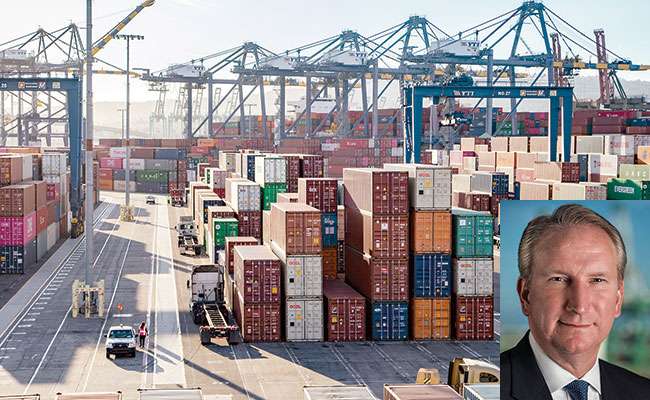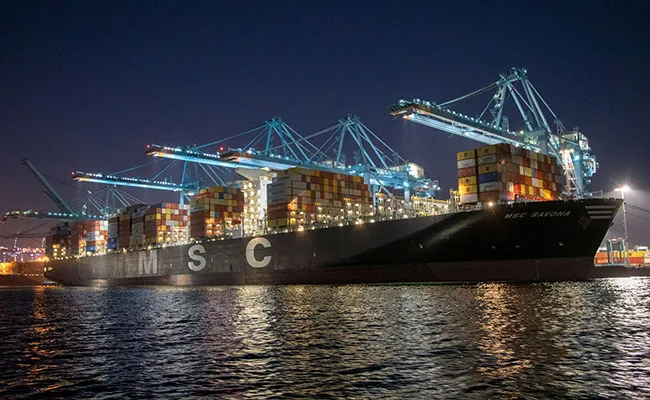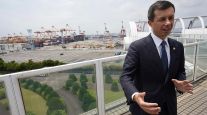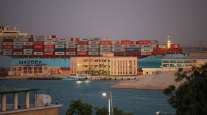Senior Reporter
Seroka Optimistic About Cargo Levels in 2024

[Stay on top of transportation news: Get TTNews in your inbox.]
As container volumes increase at the San Pedro Bay facilities, Port of Los Angeles Executive Director Gene Seroka said in a Transport Topics interview that the first quarter of 2024 is shaping up to be strong, and the rest of the year looks as though more typical cargo levels will return.
He said, however, there still is uncertainty because of increasing Houthi rebel attacks against shippers in the Middle East and concerns over the water level in the Panama Canal, which is limiting the number of vessels that can journey through the critical waterway.
“Here in quarter one, we’ll see a 20% bump in volume to about 2.2 million TEUs, so I like where we are positioned right now,” Seroka said. “You’ve got the drought concerns in the Panama Canal and the piracy problems in the Red Sea leading into the Suez Canal.
“I was just in Southeast and South Asia last month, and what importers and exporters are telling me is that they are starting to move a few more bookings to the West Coast, specifically Los Angeles. There is no quick fix to what is happening now with the Houthi rebels. They are more sophisticated, wealthier and have more assets to chase down ships.”
Seroka praised the work of the U.S. and British military for their action and said more nations need to join the effort to stop what Federal Maritime Commissioner Carl Bentzel calls a modern-day version of the Barbary pirates, who were active from medieval times to the 1800s.
In January, the Los Angeles port processed 855,652 containers, up nearly 18% compared with 726,013 a year ago.
Seroka said as a result of the concerns in the Red Sea and Panama, prices to ship items to East Coast ports have increased. Cargo into West Coast ports costs $3,000 to $5,000 less because of the longer shipping times to the Atlantic Ocean ports, which include Savannah, Ga.; Charleston, S.C,; Virginia, Baltimore and New York-New Jersey.
VIDEO: Port of Los Angeles Executive Director Gene Seroka discusses cargo volume, supply chain outlook and what the West expects moving forward with @ptsweeney and @emily_graffeo on @BloombergRadio @podcasts. https://t.co/3wlpvJUe1o — Port of Los Angeles (@PortofLA) February 22, 2024
Seroka said another concern of shippers is the status of labor talks involving the International Longshoremen’s Association, which represents an estimated 70,000 dockworkers, and the United States Maritime Alliance, which is negotiating on behalf of employers at 36 ocean ports, including three of the five busiest on the East Coast and Gulf of Mexico — New York-New Jersey, Savannah and Port Houston.
The six-year agreement expires Sept. 30, and the union’s leadership has insisted there will be no extension of the current deal.
In a letter to members last month, the National Retail Federation expressed alarm over the slow pace of contract talks and urged both sides to return to the bargaining table.
“The discussions have been on hold for months, and talk of potential disruptions has increased. Even the threat of disruption can have a negative economic impact on the covered ports,” NRF President Matthew Shay wrote, “especially if cargo owners and other supply chain stakeholders believe that operations will be slowed or shut down during the all-important peak shipping season this fall.”
In some cases, Seroka said the state of the East Coast negotiations resembles what the West Coast facilities went through a year ago when the International Longshore and Warehouse Union and the Pacific Maritime Association negotiated a new five-year contract. But in that case, the union’s leadership elected to stay at the negotiating table past the contract extension deadline and continued talks for several months until a deal was reached.
“The collective bargaining process works. The two sides stayed at the table collectively and worked on their issues. These workers deserve to be paid, and the companies need to have a shot at bringing more cargo in,” Seroka said. “We are closely watching the contract talks and have friends on both sides, obviously, in this industry.
“Many of those representing the company’s interests are the same people negotiating the contract on the East Coast, and we want to make sure they reach a good resolution.”
To improve efficiency at the ports, Bentzel continues to push for greater transparency in shipping so that customers can track their items for days or weeks across thousands of miles of water, then by truck or rail to their final destinations, not unlike how Amazon, UPS and FedEx do now with package delivery.

A containership at the Port of Los Angeles is unloaded at night. (Port of Los Angeles)
Seroka said that the system already is in place at the Port of Los Angeles.
“We have breakdowns for the cargo that is coming in here on the import side, and about 95% of all of the cargo that comes through the Port of Los Angeles is inside that Port Optimizer,” he explained. “About 4,000 companies are using this project now, and it is done as a customer service. They’re not paying for it. We use information from the U.S. Customs, and we layer that with the vessel manifests, and we work with the railroads, the trucking firms and the marine terminals.”
Want more news? Listen to today's daily briefing below or go here for more info:




